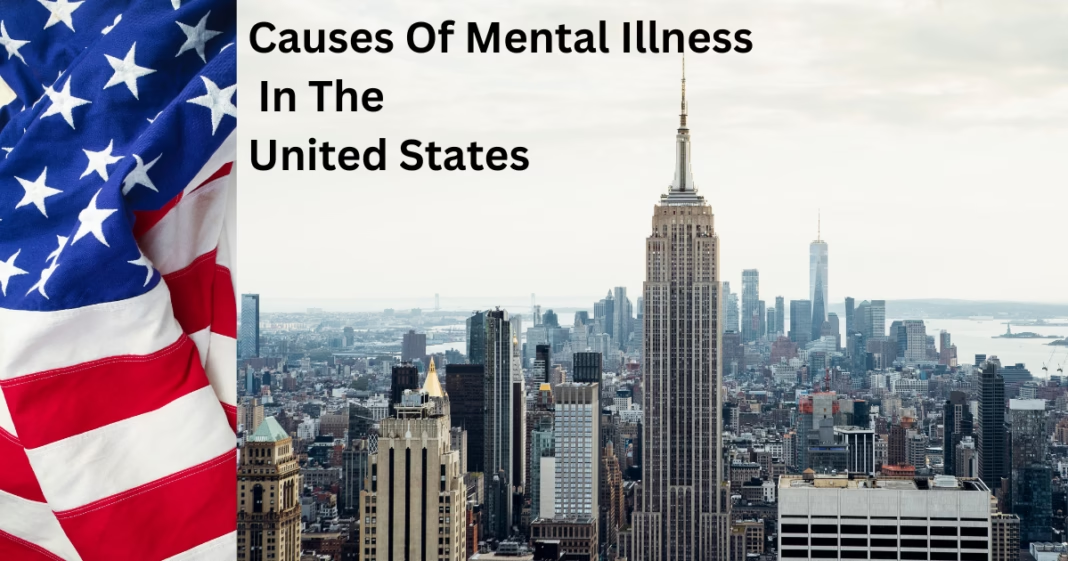Mental Health Issues in 2024: Causes and Solutions
Mental illness is a major problem affecting millions of people in the United States. As we enter 2024, it is important to understand why this problem is on the rise and the factors that contribute to it. Mental health issues can affect people of all ages and backgrounds; they can cause difficulties in personal, professional, and social lives.
This post explores the main causes of mental illness. They include genetics, lifestyle, and social pressures. By raising awareness about these causes, we are trying to reduce the stigma that exists in society and create a healthier, more compassionate society. Understanding mental illness is not just about identifying the problem; it is also about working together to help those in need and create better mental health for everyone.
With important information for 2024, we will take an in-depth look at the causes of mental illness.
Understanding the Growing Mental Health Challenges
Mental health issues remain a major threat in the United States. Millions of Americans suffer from anxiety, depression, and bipolar disorder. In 2024, social, economic, and lifestyle changes have combined to exacerbate these problems.
One major reason is the increasing stress in our daily lives. Many Americans are struggling with mental health issues due to high-pressure jobs, financial hardship, and work-life imbalance. The COVID-19 pandemic has had a long-term impact. Feelings of loneliness and uncertainty are affecting many.

Another reason is the lack of accessible mental health care. In rural and developing communities, mental health services are often underserved. Many people lack adequate support. Even in urban areas, high costs and long wait times create barriers to seeking treatment.
Social media also plays a role in mental health issues. While it helps connect people, excessive use has been linked to issues such as low self-esteem, cyberbullying, and unrealistic expectations, especially among young people.
Furthermore, the stigma surrounding mental illness remains a problem. Despite increased awareness, many people avoid seeking help for fear of judgment or misunderstanding. This stigmatization prevents early intervention, which is crucial for treatment.
Understanding these challenges is the first step to creating better solutions. Together, we can work to address these issues and build a society where mental health is prioritized and supported for everyone.
The Role of Genetics and Family History
Genetics and family history play a key role in understanding mental health problems in the United States. Research shows that some mental health disorders, such as depression, bipolar disorder, schizophrenia, and anxiety disorders, can run in families. This means that if someone in the family has a mental health disorder, they are more likely to develop the same disorder.
It is not certain that a mental health disorder is caused by genes. However, some people may be more susceptible to environmental factors, such as genetic predisposition. For example, if someone in the family has a history of depression, they may be more likely to be affected by physical trauma, chronic stress, or substance abuse.
Studies conducted in the United States have identified specific genetic markers associated with some mental health disorders. While these findings have expanded our understanding, they cannot say that genes alone are the cause of mental health challenges. The interaction of nature and nurture is important. For example, a supportive family environment can help reduce risk, but harmful relationships or adverse childhood experiences can make them worse.
Understanding one’s family history is important for early detection and prevention. People who know that a mental illness runs in their family can look out for signs and seek help early. Mental health advocates in the US encourage families to have open conversations about mental illness, which can help reduce stigma and provide early intervention.
Americans should strive to gain a deeper understanding of mental illness, considering both genetic factors and family history, and to develop additional methods for prevention and treatment.
The Impact of Stress and Lifestyle Factors

Stress and lifestyle are the leading causes of mental health problems in the United States. With modern life changing rapidly, many Americans face constant stress from work, family responsibilities, economic pressures, and social expectations. If this stress persists for long periods of time, mental health can suffer, leading to problems such as increased anxiety, depression, and burnout.
Lifestyle choices also play a major role in mental health. Insufficient sleep, lack of exercise, and unhealthy eating habits are common in the United States, which can negatively affect mental health. For example, insufficient sleep can affect mood and thinking ability. Eating a lot of processed foods can cause constant fatigue and irritability. In addition, a sedentary lifestyle reduces the secretion of mood-boosting endorphins, making mental health problems more likely.
Another major lifestyle factor associated with mental health problems is substance abuse. Many Americans rely on alcohol, smoking, or drugs to cope with stress, which can cause or worsen mental health problems. According to studies, substance abuse disorders often coexist with mental illnesses, creating a cycle that is difficult to break.
Work-life imbalance exacerbates stress-related mental health problems. Long work hours and little time for self-care or social activities create loneliness and hopelessness.
By managing stress and promoting healthy lifestyle habits, America can take a major step toward reducing the rate of mental health problems and improving overall well-being.
Social and Economic Pressures Affecting Mental Wellbeing
Social and economic pressures are major causes of mental illness in the United States. These factors create major challenges for individuals, affecting their mental health and overall well-being.
Lack of economic stability is a major stressor for many Americans. Rising costs of living, student debt, and housing shortages are leaving people struggling to make ends meet. Money problems often lead to anxiety, depression, and health problems as people face uncertainty about their future. Unemployment or lack of job security can further burden them, increasing the risk of mental illness.
In the age of social media, social pressures are also a significant concern. Many Americans are driven to meet the standards of success, beauty, and lifestyle displayed online. This constant comparison, especially among younger generations, leads to feelings of inadequacy and low self-esteem.
Additional social factors that affect mental health include stigma and inequality. Minority communities in the United States often face persistent stress, psychological trauma, and greater mental health challenges.
Furthermore, the lack of affordable mental health care exacerbates the problem. High costs or lack of adequate insurance coverage mean that many people do not receive the support they need, perpetuating the cycle of stress and untreated mental illness.
Addressing these social and economic pressures is critical to improving mental well-being. By fostering equity, providing economic support, and increasing access to mental health care, America can create a healthy and supportive environment for all.
Addressing Gaps in Mental Health Awareness and Support

If the mind is not right, the world is not right! (If the mind is not right, the world is not right!)
Lack of awareness about mental health is the main reason for mental health problems in America. Although many people have started talking about mental health, there are many barriers to seeking treatment.
The main problem is misconceptions about mental health. Many people are afraid to talk about their problems. They think that they will not be understood properly. This fear prevents them from seeking treatment at the right time. It is better to seek treatment at the right time.
Another big problem is the difficulty in getting mental health treatment. In rural areas, there is a shortage of psychiatrists, so it is very difficult to get treatment at the right time. Even in cities, there are many problems such as long waiting times, high costs, and insufficient insurance.
Awareness campaigns and educational programs can help solve these problems. Schools, workplaces, and community organizations should encourage people to talk about mental health and learn how to recognize the signs of mental health problems. The government should provide more funding for mental health programs. Telehealth services should also be expanded.
Peer support programs and local community resources are very important. These programs bring people together who are facing similar problems, which creates unity and reduces loneliness.
By prioritizing awareness and support, America can act with an open mind to addressing mental health problems. No one should be denied access to mental health care.
This translation uses simpler Tamil words and phrases, avoids direct translations of English medical jargon, and aims for a conversational and engaging tone suitable for a Tamil blog. It also incorporates a common Tamil expression to emphasize the importance of mental well-being.
Conclusion
Mental health issues are a major challenge in the United States. They affect all types of people. There are many factors that contribute to the problem, including genetics, family history, stress, lifestyle, social and economic pressures. Understanding all of these factors can help us find better solutions.
The gaps in mental health awareness and access to help are a challenge that we all need to work together to overcome. We need to address these gaps and create a society that values mental health. We need to work hard to ensure that those who need help get help.
In 2024, we can work to raise awareness, increase access to help, and create a welcoming environment where everyone can seek help. Together, we can reduce the number of mental health problems and create a healthier future for Americans.
What are the most common causes of mental illness in the United States?
Mental illness in the United States is often caused by a combination of factors, including genetic predispositions, family history, chronic stress, trauma, substance abuse, and social or economic pressures. Lifestyle choices such as poor diet, lack of exercise, and insufficient sleep can also contribute to mental health problems.
How can I tell if someone might be experiencing mental illness?
Symptoms of mental illness can vary but include persistent sadness, anxiety, or hopelessness, withdrawal from friends and family, changes in sleep or eating habits, difficulty concentrating, or engaging in risky behaviors. If you see these signs in someone, encourage them to seek help from a mental health professional.
What resources are available for mental health support in the United States?
The U.S. offers a variety of resources, including hotlines such as the National Suicide Prevention Lifeline (988), local mental health clinics, online treatment sites, and community support groups. Many employers also offer employee assistance programs (EAPs) for mental health care.
How can we reduce stigma around mental illness in the United States?
Reducing stigma requires open conversations about mental health, education about mental illness, and promoting empathy. Media campaigns, social welfare programs, and mental health education in schools play a significant role in normalizing discussions and fostering acceptance.




